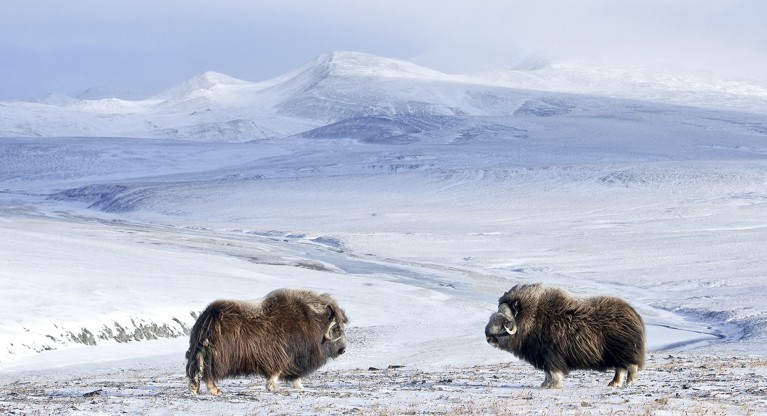Extreme Conservation: Life at the Edges of the World Joel Berger University of Chicago Press (2018)
I write this from a Russian icebreaker on a voyage to the North Pole. On board are passengers from many countries, their reasons for heading into this most extreme of environments ranging from the deeply personal to the mildly boastful. One wants to “see the ice before it’s too late” (this winter, the maximum extent of Arctic sea ice was the second-lowest on record). For most, wildlife is a major draw, and king of all is the polar bear. Ursus maritimus, the ‘sea bear’, has become the symbol of the high Arctic and the poster-child for ecological crisis.
Many more species of the cold wilderness share their uncertain future, reveals conservation biologist Joel Berger in Extreme Conservation. Berger has trailed yaks (Bos mutus) on the Tibetan Plateau and the proboscis-swinging saiga (Saiga tatarica) through Mongolia’s Gobi Desert. He has tracked one species for more than a decade. “If polar bears are the face of climate change,” he writes, “muskoxen are the heart.” This hairy, horned Arctic bovid (Ovibos moschatus), neither an ox nor a maker of musk, once roamed with woolly mammoths. Yet we still know very little about its physiology, reproduction, predation or food sources; least of all about its adaptive capacity.
Up close and personal
To study the musk-ox life cycle demands considerable effort and expense. The hostile conditions are especially complex in winter, with severe blizzards and temperatures far below freezing. But by helicopter and snowmobile, the indefatigable Berger perseveres. He mostly eschews radio collars for less intrusive data-collection methods, such as analysing frozen dung for stress hormones, and photogrammetry — assessing an animal’s health from photographs.
Musk oxen were extirpated from Alaska during the quarter of a century after the United States purchased the land from Russia in 1867. In the 1930s, efforts began to re-introduce the species to its former range: juveniles captured in Greenland were transported by ship, rail and boat by way of Norway to Nunivak Island in the Bering Sea. Descendants of the 27 animals that completed the trip were then moved throughout Alaska, and even to Russia’s Wrangel Island, north of Siberia; the United States offered these animals to the then-Soviet Union during the cold war as a token of friendship — a kind of panda diplomacy. Efforts to maintain and restore populations of the enigmatic creatures are now thwarted by the effects of global warming. Berger has made it his life’s mission to understand the mechanisms through which these changes affect populations.
He is an excellent guide, a respected ecologist and a gifted storyteller. It’s an important combination in environmental advocacy: scientists who can tell compelling stories can elevate their research outputs. His previous books include Wild Horses of the Great Basin (1986), the Horn of Darkness (1997; written with Carol Cunningham) and the 2008 The Better to Eat You With. In his 2008 book, he tracks cultures of fear in animals across continents and climates, from elk and wolves in the US Yellowstone National Park to moose coexisting with tigers and bears in Asia. He opens our eyes to what it takes for such animals to cling to the edges of existence.
Trapped in the ice
Independent studies by agencies such as NASA and the US National Oceanic and Atmospheric Administration have shown, year on year, that global average surface temperature is rising and that warming patterns are most extreme in the polar regions. One of the most troubling recent observations in the Arctic is that the number of winter days when temperatures don’t drop below freezing is increasing. Precipitation falls as rain, melting snow on the ground; when the real cold returns, lichens and grasses are encased in steel-hard ice, impenetrable to hooves. In the early 2000s, Berger relates, such an event on Canada’s Banks Island led to the deaths of some 20,000 musk oxen. And other extreme events are becoming more common. In 2011, more than 50 were entombed in ice during a Chukchi Sea winter tsunami (ivuniq in the Iñupiat language of northwestern Alaska); elsewhere, rapid freezing has entrapped whales and sea otters.
Freak weather and storms of great intensity are aspects of an alarming reality not confined to the Arctic. Worldwide, biodiversity loss is accelerating at an unprecedented rate. For Berger and his peers, it has become a moral obligation to apply their knowledge to ecological well-being. “Doing science is not conservation,” Berger writes. “Donning a human face, inspiring people to care, engaging people who listen, and ultimately persuading decision makers to act is.”
Berger’s methods can be eccentric. He pitches carnivore dung at moose, baseball-style, to see whether they respond to the scent, or wears a polar-bear costume made from cloth and styrofoam to get close to musk oxen and study their reactions. “He is the hairy-arsed action-man academic,” The Times newspaper once wrote. His data, gleaned primarily from northern latitudes and extreme heights in the Himalayas, are in my view all the more insightful for that.
What Berger’s fieldwork shows us is that the more adapted a species has become to its ecological niche, the more devastating climate change can be for it. With receding sea ice, polar bears find it more difficult to hunt seals, their favoured prey, and now forage more widely onshore, for example on eggs of migratory waterfowl. The melt shrinks their hunting season and the time they have to rest and breed, which they normally do on sea ice. “Life at the extremes is more challenging than ever,” he writes, “and the need for action, for solutions, has never been greater.”
We need to remember, too, that cold-adapted species have survived “across thousands of generations”, Berger notes. A fraction of that time is left for us to curb the impacts of climate change.


 Wild at heart
Wild at heart
 Among the lemurs
Among the lemurs
 Primatological derring-do
Primatological derring-do




